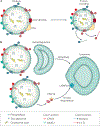Lipid droplets and liver disease: from basic biology to clinical implications
- PMID: 28428634
- PMCID: PMC6319657
- DOI: 10.1038/nrgastro.2017.32
Lipid droplets and liver disease: from basic biology to clinical implications
Abstract
Lipid droplets are dynamic organelles that store neutral lipids during times of energy excess and serve as an energy reservoir during deprivation. Many prevalent metabolic diseases, such as the metabolic syndrome or obesity, often result in abnormal lipid accumulation in lipid droplets in the liver, also called hepatic steatosis. Obesity-related steatosis, or NAFLD in particular, is a major public health concern worldwide and is frequently associated with insulin resistance and type 2 diabetes mellitus. Here, we review the latest insights into the biology of lipid droplets and their role in maintaining lipid homeostasis in the liver. We also offer a perspective of liver diseases that feature lipid accumulation in these lipid storage organelles, which include NAFLD and viral hepatitis. Although clinical applications of this knowledge are just beginning, we highlight new opportunities for identifying molecular targets for treating hepatic steatosis and steatohepatitis.
Conflict of interest statement
Competing interests statement
The authors declare no competing interests.
Figures






References
-
- Fazel Y, Koenig AB, Sayiner M, Goodman ZD & Younossi ZM Epidemiology and natural history of non-alcoholic fatty liver disease. Metab. Clin. Exp 65, 1017–1025 (2016). - PubMed
-
- Haas JT, Francque S & Staels B Pathophysiology and mechanisms of nonalcoholic fatty liver disease. Annu. Rev. Physiol 78, 181–205 (2016). - PubMed
Publication types
MeSH terms
Substances
Grants and funding
LinkOut - more resources
Full Text Sources
Other Literature Sources
Medical

